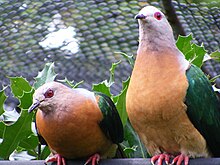| Imperial pigeon | |
|---|---|

| |
| Purple-tailed imperial pigeon (Ducula rufigaster), endemic to New Guinea | |
| Scientific classification | |
| Domain: | Eukaryota |
| Kingdom: | Animalia |
| Phylum: | Chordata |
| Class: | Aves |
| Order: | Columbiformes |
| Family: | Columbidae |
| Subfamily: | Ptilinopinae |
| Genus: | Ducula Hodgson, 1836 |
| Type species | |
| Ducula insignis[1] Hodgson, 1836
| |
Ducula is a genus of the pigeon family Columbidae, collectively known as imperial pigeons. They are large to very large pigeons with a heavy build and medium to long tails. They are arboreal, feed mainly on fruit and are closely related to the other genus of fruit-eating doves, Ptilinopus. Both genera display brightly coloured plumage, predominantly green, often with contrasting under-parts of purple, orange or red. Some Ducula have prominently swollen ceres.[2] They have large gapes and swallow seeds whole, playing an important role in seed dispersal.[3]
Imperial pigeons are found in forests of southern Asia, New Guinea, northern Australia and the Pacific islands. Many species are nomadic, travelling long distances to exploit seasonal fruit sources. Some undertake migrations and all are strong fliers.[2] Because of habitat loss and predation, species of Ducula are amongst the most threatened of avian species globally.[4]
- ^ "Columbidae". aviansystematics.org. The Trust for Avian Systematics. Retrieved 5 August 2023.
- ^ a b Goodwin, Derek (1983). Pigeons and Doves of the World. London: British Museum of Natural History.
- ^ Lambert, Frank (1989). "Pigeons as seed predators and dispersers of figs in a Malaysian lowland forest". Ibis. 131 (4): 521–527. doi:10.1111/j.1474-919x.1989.tb04788.x.
- ^ Walker, Jonothan (2007). "Geographical patterns of threat among pigeons and doves (Columbidae)". Oryx. 41 (3): 289–299. doi:10.1017/s0030605307001016.